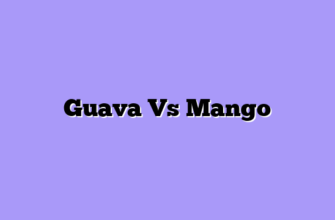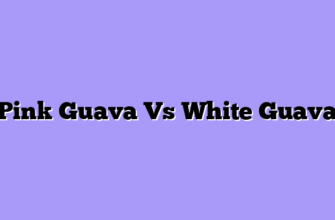Agave and guava, while both originating in the Americas, offer distinct flavor profiles and culinary applications. Agave, a succulent plant native to Mexico, is primarily known for its nectar, a sweet syrup extracted from its heart. Guava, a tropical fruit native to Central America, boasts a vibrant, tangy flavor and a unique texture. Understanding their differences can help you make informed choices when incorporating these ingredients into your cooking and baking.
A Taste Comparison
Agave nectar, often touted as a natural sweetener, possesses a mild, honey-like flavor with a subtle floral note. Its sweetness is derived from fructose, making it sweeter than sugar by volume. This characteristic makes it a popular choice for those seeking a less-processed alternative to refined sugar. However, agave nectar’s high fructose content has raised concerns about its potential health implications.

When comparing their taste, agave nectar’s sweetness is straightforward and readily apparent. It provides a clean, unadulterated sweetness that can be used to enhance the flavor of various dishes. Guava, however, offers a more nuanced taste experience. Its sweetness is often balanced by a tartness that adds complexity and depth to its flavor. This combination of sweet and tart makes guava a versatile ingredient that can be used in both sweet and savory dishes.
Beyond their taste, agave and guava also differ in their nutritional profiles. Agave nectar is primarily composed of carbohydrates, with minimal amounts of vitamins and minerals. Guava, however, is a rich source of vitamin C, fiber, and antioxidants. Its high vitamin C content makes it a valuable addition to a healthy diet.
Nutritional Value
Agave, derived from the agave plant, is a natural sweetener known for its high fructose content. It is often used as a substitute for sugar in various recipes, including beverages and desserts. While agave provides a quick source of energy, its high fructose content raises concerns about its potential impact on metabolic health. Excessive fructose consumption has been linked to increased risk of non-alcoholic fatty liver disease, insulin resistance, and type 2 diabetes.
Guava, on the other hand, is a tropical fruit rich in vitamins, minerals, and antioxidants. It is a good source of vitamin C, which plays a crucial role in immune function and collagen production. Guava also contains potassium, a mineral essential for maintaining blood pressure and muscle function. Additionally, guava is a rich source of dietary fiber, which promotes digestive health and helps regulate blood sugar levels.
In terms of their nutritional value, guava emerges as a more wholesome choice compared to agave. While agave provides a quick energy boost, its high fructose content poses potential health risks. Guava, with its abundance of vitamins, minerals, and fiber, offers a more balanced and nutritious option.
Furthermore, guava’s low glycemic index (GI) makes it a suitable choice for individuals managing blood sugar levels. The GI measures how quickly a food raises blood glucose levels. Foods with a low GI are digested slowly, leading to a gradual rise in blood sugar, which is beneficial for individuals with diabetes or those seeking to maintain stable blood sugar levels.
Agave, with its high fructose content, has a higher GI compared to guava. This means that agave can cause a rapid spike in blood sugar levels, potentially leading to insulin resistance and other metabolic complications.
Culinary Uses
Agave nectar, often referred to as agave syrup, has gained popularity as a natural sweetener. Its mild, honey-like flavor and high fructose content make it a suitable substitute for sugar in various recipes. It is commonly used in beverages, desserts, and sauces, adding a touch of sweetness without overpowering other flavors. However, it is important to note that agave nectar is still high in calories and should be consumed in moderation.
Guava, on the other hand, offers a unique combination of sweetness and tartness. Its flesh, ranging from white to pink to red, is rich in vitamins, minerals, and antioxidants. Guava can be enjoyed fresh, adding a burst of flavor to salads and fruit platters. It is also commonly used in jams, jellies, and chutneys, where its tartness balances the sweetness of other ingredients.

While agave and guava share a common origin, their culinary uses diverge significantly. Agave nectar serves as a sweetener, adding a touch of sweetness to various dishes. Guava, with its vibrant flavor and versatility, finds its way into a wide range of culinary applications, from fresh fruit salads to jams and chutneys. Both ingredients offer unique culinary experiences, enriching the world of food with their distinct flavors and textures.
Health Benefits
Agave is a rich source of fructose, a type of sugar that is readily absorbed into the bloodstream. While it provides a quick energy boost, excessive fructose consumption can contribute to metabolic issues, such as insulin resistance and fatty liver disease. Additionally, agave’s high fructose content may lead to increased inflammation and oxidative stress, potentially increasing the risk of chronic diseases. However, agave does contain small amounts of vitamins and minerals, including potassium and calcium.
Guava, in contrast, is a nutritional powerhouse packed with vitamins, minerals, and antioxidants. It is an excellent source of vitamin C, which plays a vital role in immune function and collagen production. Guava also contains significant amounts of vitamin A, potassium, and fiber. The high fiber content in guava promotes digestive health, regulates blood sugar levels, and contributes to a feeling of fullness, aiding in weight management. Furthermore, guava’s antioxidants help protect against cell damage caused by free radicals, reducing the risk of chronic diseases such as heart disease and cancer.
While agave offers a sweet alternative to refined sugar, its high fructose content raises concerns about its long-term health implications. Guava, on the other hand, provides a wealth of essential nutrients and antioxidants, making it a healthier choice for overall well-being. However, it’s important to note that both agave and guava should be consumed in moderation as part of a balanced diet.
A Guide for Home Gardeners
Agave, a succulent plant known for its striking architectural form, is renowned for its slow growth and drought tolerance. Its fleshy, spiky leaves, often arranged in a rosette pattern, can reach impressive sizes, adding a dramatic touch to any landscape. Agave is a low-maintenance plant, requiring minimal watering and fertilization. However, its sharp spines necessitate caution during handling and placement. The plant’s primary appeal lies in its versatility, as its leaves can be used to produce tequila, mezcal, and other alcoholic beverages, while its sap can be harvested for syrup and sweeteners.
Guava, on the other hand, is a fast-growing, deciduous shrub or small tree that produces fragrant, edible fruits. Its leaves are oval-shaped and glossy, providing a lush, tropical feel to the garden. Guava thrives in well-drained soil and requires regular watering, especially during dry periods. Its fruits, ranging in color from green to yellow to red, are rich in vitamins and antioxidants, making them a nutritious addition to any diet. Guava trees are relatively easy to propagate from seeds or cuttings, allowing for quick establishment in the garden.
When choosing between agave and guava, several factors should be considered. Agave’s slow growth and low-maintenance nature make it an ideal choice for gardeners seeking a long-lasting, drought-tolerant plant. Its striking appearance and versatility add a unique dimension to the landscape. However, its sharp spines and potential for invasive growth require careful planning and placement.
Guava, with its rapid growth and delicious fruits, appeals to gardeners seeking a quick source of fresh produce. Its fragrant flowers and lush foliage enhance the garden’s aesthetic appeal. However, guava requires more frequent watering and fertilization than agave, making it a more demanding plant to cultivate.
Ultimately, the decision between agave and guava depends on individual preferences and gardening goals. Agave offers a low-maintenance, drought-tolerant option with a striking appearance and versatile uses. Guava, on the other hand, provides a fast-growing, fruit-bearing plant that adds a tropical touch to the garden. By carefully considering their unique characteristics and requirements, home gardeners can make an informed decision that aligns with their specific needs and desires.
Q&A
**1. What are they?**
* **Agave:** A succulent plant native to Mexico, known for its sweet sap used to make syrup and tequila.
* **Guava:** A tropical fruit native to Central America, known for its sweet and slightly tart flavor.
**2. What do they taste like?**
* **Agave:** Sweet, with a slight honey-like flavor.
* **Guava:** Sweet and tart, with a slightly floral aroma.
**3. What are their nutritional benefits?**
* **Agave:** Rich in fructose, a simple sugar, and contains some vitamins and minerals.
* **Guava:** High in vitamin C, fiber, and antioxidants.
**4. How are they used?**
* **Agave:** Used as a sweetener in food and beverages, and to make tequila.
* **Guava:** Eaten fresh, used in jams, jellies, juices, and desserts.
**5. Are they related?**
* **No.** Agave is a plant, while guava is a fruit. They are not related botanically.








